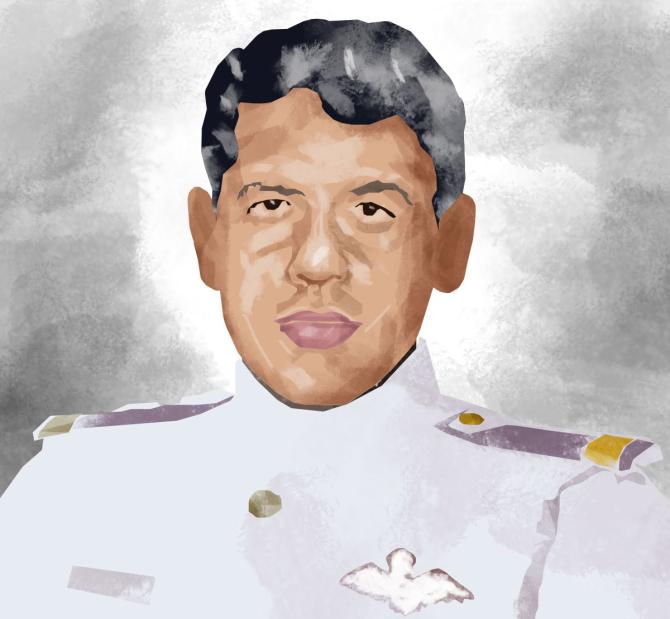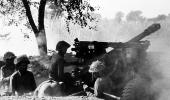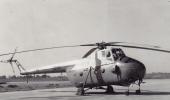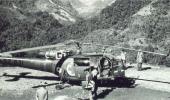'Our men had suffered so much pain for the independence of other people in a foreign land.'
Air Commodore Nitin Sathe continues his fascinating year-long series on the 1971 War, 50 Years On.

- Part 1: Meet War Hero 'Keen Kumar'
- Part 2: A brave Dakota pilot's contribution
The helicopters joined in around the evening of December 5, 1971.
General Sagat Singh and then Group Captain Chandan Singh planned to use helicopters for the insertion of troops into East Pakistan.
Airlifting troops from the 4/5 Gurkha Rifles across the Meghna river started the race between Indian commanders towards Dacca."
"It was fun to interact with the chopper boys, but finding a place to sleep became a problem!
"We were packed like sardines in the passenger hall of the airfield now.
"There were some immediate seniors and juniors in the crowd. It was good to meet some of them after our association at the academy.
"We shared news of what we learnt on missions and on the radio.
"We came to know that a few of our friends had lost their lives in the operations but there was no time to grieve. We chatted through the night till sleep overtook us.’
"The chopper boys did an excellent job without a single casualty, although they got a few bullets into their machines. Their josh and morale was sky high; it was evident when every single and some double hands were raised when the flight commander asked for volunteers!" says Air Commodore Arun Dattraya Karandikar (retd), who sadly passed into the ages on Sunday, June 13, 2021.
Later, the operations shifted southwards from Sylhet (in Bangladesh) and troops from the 57 Mountain Division were inserted without mishap with the help of Mi-4s from three units -- namely 111 Helicopter Unit, 115 HU and 110 HU.
"As the operations progressed, a large number of casualties started landing up with the Mi-4s's return trips as well as by road. Most of the soldiers had apparently suffered mine-blast injuries as the lower half of their bodies had sustained maximum damage. It wasn't a pleasant sight."
"Their oozing wounds were barely covered with some gauze. While some of the soldiers were in a coma, some were delirious and required to be sedated.
"Our men had suffered so much pain for the independence of other people in a foreign land."
The doctors had a makeshift medical assistance room where the preliminary stabilisation of patients took place before they were boarded onto the waiting Dakota and Packet aircraft to be taken to various hospitals right up to Calcutta.
"One thing that was wondrous about these doctors was that they worked day and night without rest and did not discriminate between the patients.
"Be it an injured POW or an Indian jawan, the priority for airlift was given as per the grievousness of the injury," recalled the air commodore with pride.
"Since the Dak wasn't modified to carry patients, we would keep the stretchers on the floor or make the casualties sit, if they could, on the canvas seats in our aircraft.
"We also had to ensure smooth rides for them since there was no way to secure the stretchers. The smell of blood, coupled with the smell of ammonia and medicines, still makes me shudder," remembered the veteran soldier.
After the war
Meanwhile, the end of the war was certain and East Pakistan was capitulating.
On December 15, 1971, the 4/5 GR troops who had fought the battle of Sylhet and won hands down had to be airlifted to Agartala (Tripura).
They had fought well and deserved to be back to their barracks as soon as possible to recuperate. Young Karandikar was detailed to fly these troops in his trustworthy Dak.
"I flew through the day and almost up to midnight, carrying out 15 take-offs and landings between Kailashahar (Tripura) and Agartala. It was back-breaking work, but the happiness we saw on the returning soldiers's faces was the tonic we needed to go on! I remember that the take-offs and landings from both these airfields were not easy, especially at night.
"Kailashahar had just six sets of 'goosenecks' (thick burning wicks dipped in oil) placed at the beginning of the runway.
"Agartala was the worst. It had just a few lights placed on only one edge of the runway! Aligning the aircraft was a problem and so was depth perception.
"This coupled with the short length of the strips meant that there was no margin for error.
"Every time I was aligned for landing at Agartala, I would reconfirm from the ATC as to which side of the runway the lights were placed!"
Having been in the field of military aviation for so many years myself, I can say with absolute certainty that the pilots of those days were a class apart.
To fly such big machines, which had just the bare instruments and no 'auto pilot' to help you fly (especially at night) and that too land on an unlighted runway, needed guts and above all perfect flying skills that the new generation of 'button pilots' don't have! It was pure 'seat of the pants' flying, relying on your guts and excellent training.
Ask any pilot today if he would do what those guys did in 1971 and you will get a big NO for sure!
Before that, the Dakotas were used to move the Kilo Flight, lock stock and barrel, to Agartala around December 9-10.
Their role in the war was now almost negligible and they were excited to get back to their own independent country with the aeroplanes to form the Bangladesh air force.
"Have you seen that famous photo of the surrender at Dacca?"
"I have my little story about that too," revealed the veteran pilot.
"On December 16, I was allowed by Group Captain Chandan Singh to go to Dacca in the choppers that were going there for the surrender ceremony.
"I flew with my friends and was amazed at the reception at Dacca after landing.
"En route, we had seen the silent Pakistani anti-aircraft guns and the troops lined next to them with their arms placed on the ground.
"The cheering crowds at Dacca received us as heroes and carried us on their shoulders.
"There was a happy mayhem on the streets which I remember clearly.
"I was standing right next to the table when the document was being signed; however, I saw some of my army course mates at the venue and went to greet them. If I hadn't, I would have also been there in that historic photograph!"
"I had flown a total of 49 sorties, of which five were as a single pilot on the Dakota, in 14 days, including 15 sorties on one day!
"It had been an experience of a lifetime for me.
"Although I hadn't faced many enemy bullets due to the kind of flying that the Dakota did, it was a great experience to land on unprepared short runways and that too at night without lights and, of course, sometimes all alone in the cockpit, something I never got to do in the rest of my long innings in the IAF. That was indeed baptism by fire for a fledgling pilot like me!"
We had begun this conversation talking about flying the Dak with just Kandy Sir in the cockpit. While navigating through the stories of the war, we had almost forgotten this interesting aspect.
"Oh yes," he smiled, "we have rambled on, speaking of everything else but that!
"I was indeed in a bit of trauma as to how to handle the aircraft all alone when it had been designed to be flown by two and more. I decided to fly it from the left seat, which was where I was most comfortable (the left seat was the captain's seat).
"The levers that operated the undercarriage and flaps were on the side of the co-pilot. Also, I had to do all the checks myself, without the help of the second mate in the cockpit to monitor if all was going well.
"I realised a thing or two about cockpit crew resource management which was just taught in theory in our training!"
The most difficult part was the take-off from the short runway. There were trees looming in front and one had to establish a decent rate of climb to clear them; however, for this, one had to get the undercarriage up as soon as possible to reduce the drag.
So, for the single pilot, one had to first unstick clear off the ground, leave the right hand from the throttles which were at maximum, hold the controls steady with the left hand and then bend fully to the right to reach the lever that would pull up the wheels.
"Believe me, it required some doing. An inadvertent pull back on the stick would mean that you stalled the aircraft and crash and if you pushed the controls forward, the trees would get you! God forbid if there was an engine failure just then; only He could save you!!", recalled the veteran.
"In-flight, it was an eerie feeling in the cockpit and the workload was high. Especially at night, it was eerier with the ethereal glow of the ultraviolet lighting flooding the cockpit.
"Also, at night, the far east was pretty much blacked out and the moon and stars were only company if the weather gods were happy.
"All in all, the solo experience did wonders for my confidence in the aircraft and in myself, a confidence that carried me through my long innings in the Indian Air Force."

Air Commodore Arun Dattraya Karandikar retired from the IAF after 30 years of glorious service in 1997.
He holds the record for the most number of hours flown by a military pilot -- 12,980 hours -- for which he finds his name in the Limca Book Of Records.
His glorious services for the Motherland will never be forgotten.
Air Commodore Nitin Sathe retired from the Indian Air Force in February 2020 after a distinguished 35 year career.
The author of three books, you can read Air Commodore Sathe's earlier contributions here.
Feature Presentation: Rajesh Alva/Rediff.com










